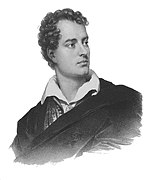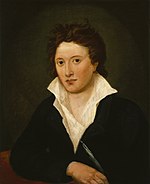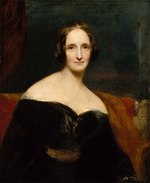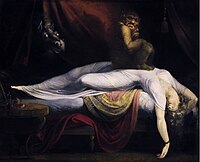Gothic (film)
| Movie | |
|---|---|
| German title | Gothic |
| Original title | Gothic |
| Country of production | Great Britain |
| original language | English |
| Publishing year | 1986 |
| length | 87 minutes |
| Age rating | FSK 16 |
| Rod | |
| Director | Ken Russell |
| script | Stephen Volk |
| production |
Penny Corke Robert Fox |
| music | Thomas Dolby |
| camera | Mike Southon |
| cut | Michael Bradsell |
| occupation | |
| |
Gothic is a film made in 1986 by Ken Russell . The combination of Horror, thriller, drama and period film with Gabriel Byrne , Julian Sands and Natasha Richardson in the leading roles discussed an incident in the life of the writer Lord Byron , Percy Shelley and Mary Shelley , as an essential event in the history of fantasy literature has been received . However , Russell only takes the historical meeting, at which the foundation stone for the novel Frankenstein was laid and which is generally regarded as the initial spark for the emergence of the fantastic, as a starting point for his own symbolic interpretation of the , among other things using the means of erotic and surrealist films to present events at the time.
action
Observed by sensation-hungry tourists, the eccentric poet Lord Byron and his personal physician Dr. John Polidori in exile in Switzerland in the Villa Diodati on Lake Geneva . The poet Percy Shelley visits with his fiancee Mary Godwin and their half-sister Claire Clairmont . Claire is Byron's lover, on the one hand disgusted by him because of his egomania and on the other hand addicted to him. The awkward Polidori, for his part, is also in love with the Lord, is supposed to write his biography and is often humiliated by him. Mary is reluctant for the time being, as she doesn't know what to do with the decadent extravagance of the others. Percy Shelley is the only one who meets Byron at least approximately at eye level, as he is impressed by Shelley's poetic work.
At dinner, Claire tries to mock the lord about his clubfoot , but he knows how to fight back. To distract themselves, society plays hide and seek in the spacious and winding rooms of the house. Mary and Percy come across all sorts of sometimes creepy, sometimes amusing peculiarities such as automatic dolls or an animal menagerie. When a thunderstorm approaches, Percy, who has taken opium, feels called to dance around naked on the roof. He expresses some wisdom about lightning as elemental energy, which Mary attentively registers. Shelley later talks about alchemy , about the work of creation and about dreams as the seat of the soul , whereupon Byron calls him the modern Prometheus .
At the fireplace, the friends take turns reading an anthology of German horror stories called Phantasmagoria and indulging in laudanum and sexual debauchery. In revenge for the humiliation, Polidori deposited leeches under a cover on the buffet , which startled Byron, who is disgusted by these animals. Claire got the idea that you could invent stories yourself. Suddenly the lightning strikes a tree, which throws eerily dancing shadows on the ceiling and leads Byron to the idea that maybe with the help of lightning one could create something living from lifeless thoughts, if only the shadow play of the tree in the imagination of those present became so alive. While the others are absorbed in the idea of creativity and the resurrection of the dead, Mary turns away in disgust. She tells Polidori about her relationship with Shelley and about a stillbirth that still affects her so badly that she sometimes has the idea that her child is still alive.
Finally, the group holds a séance with the help of a skull , during which Claire falls into a trance and gasps and tells of a traumatic incident in her childhood. Suddenly she has an epileptic fit, which Byron watches with amusement, while the others try to help her. Byron believes it was a deception, to which Mary asserts that this has happened before and that her family believed Claire was obsessed because of strange incidents that accompanied the seizures. She expresses concern to her fiancé, believing that Byron would eventually drop Claire while she fell for him.
Polidori wants to apologize for the leeches, whereupon Byron symbolically gives him absolution with red wine in order to humiliate him again. While Polidori storms out of the room crying, Byron calls a maid to the bed, puts a face mask of his half-sister Augusta on her and, weeping, caresses her body. This scene is an indication of his alleged incestuous relationship, which Mary will later hold against him.
Mary cannot sleep. In her room there is a picture of an incubus perched on a woman. The picture frightens her and while half asleep she dreams of the creature coming to life and sitting on top of her like a nightmare, only to finally attack her. When she wakes up screaming from the nightmare, Claire, with whom she shares the bed, is lying on her stomach. At the same time she thinks she sees someone on the balcony, but Shelley rushing to calm her down.
Later, the storm is still raging with undiminished severity, Percy runs to the shed of the property after noticing a banging door. When it won't close and he hears strange noises from the shed, he enters the dilapidated building. Among all kinds of objects covered by cobwebs he suddenly thinks he has discovered a hideous creature and flees screaming. When Byron finds him huddled in the entrance hall, Shelley accuses him of waking up the brood of hell with his goings-on. He is afraid of narcolepsy and of being buried alive. Byron is able to appease him, but when Mary appears, Percy escapes. Mary confronts Byron about his relationship with Claire and describes him as a self- loving vampire who can only torment others. Even when she tells him that Claire is expecting a child, Byron is unfazed and tries to kiss Mary. But she can defend herself and leaves him alone.
Byron discovers a strange slimy liquid in the basement of the house. When he thinks he sees movement, he fled, amused, into Claire's bedroom, where he found her half asleep. Blood smeared on his mouth after cunnilingus . Meanwhile, Polidori, who hears Claire's more lustful moans through the wall, can hardly bear the guilt he has instilled by his Catholic teachers. He slaps his hand over and over again on a nail stuck in the wall, on which a crucifix previously hung, and tries to get intoxicated on his blood.
Percy, who is desperately trying to stay awake, discovers a slimy trail along with Mary at the staircase to the attic. While Mary tries to interpret the find as rainwater mixed with rotten leaves in the gutter, Shelley is sure to have found the traces of the decay. He thinks he can hear Claire's laughter and hurries away. Mary, who remains jealous, suddenly discovers Polidori in the servants' stairwell with bleeding bite wounds on her neck.
Later the doctor claims to have been attacked by a vampire, but the lord does not believe a word. He accuses Polidori of inflicting the injury on himself and is the only one who believes that the group only imagined what happened. Shelley is sure that the creature they created themselves would haunt them now because they challenged God and sinned against creation.
Meanwhile, Claire lies motionless in her bed with a puddle of slime next to her on the floor.
Percy believes that they created the being as a synthesis of their unconscious fears and longings and now have to endure the punishment for it. His fiancée tries to calm him down. When the doctor divulges what Mary had previously told him in confidence, the others storm him with accusations about his homosexuality, which he could not admit in his self-hatred. Suddenly they hear a scream from Claire's bedroom. Shelley armed himself with a revolver, but when he fired at a figure arriving in the room, he only noticed that he had shot at his own reflection. Claire has disappeared, however. He finds her half-naked in the pool room, but her nipples have turned into eyes. The doctor wants to poison her in his madness, he thinks he sees in her the cause of the whole haunt .
Byron is convinced that they should bring the monster back to where it came from in a new séance. However, Polidori does not want to participate and tries to shoot Shelley and the Lord. However, the gun is not loaded. When they both laugh at him, he rushes off to hang himself on the back of a horse in the shed. However, he does not make it because the rope comes loose from the beam as the horse starts running. Sitting on the ground, the doctor sees a creature land on the horse galloping away and ride away.
Meanwhile, Mary, Percy and the Lord are looking for Claire because they need her for their séance. You find her naked and terribly filthy, biting a rat to death in the cellar. While Byron and Shelley also take off their clothes and smear themselves with dirt, Mary hesitates. She is still of the opinion that the Lord is incarnate and accuses him of having slept with his own sister, whereupon he throws her to the ground in anger. When the other three want to start with the skull from the first session, Mary breaks it in two with a stone. She tries to stab Byron with a splinter, but Shelley stops her. She takes refuge in her room and locks herself in when suddenly someone calling her “ Mama ” turns the doorknob. She opens the door and sees her child, William, laid out in the stairwell.
When she closes the door behind her, she suddenly finds herself in a circular room with many doors. When she finally opens the initially closed doors, she has several disturbing visions. She witnesses the birth of her child, sees how the others carry it to their grave, how cockroaches crawl out of the mouth of the dead Polidoris and how she herself laid her newborn next to a skeleton of himself. She watches as Percy drowns, covered in earth while still alive, and burned at a stake on a beach. She finds the lord, covered with leeches, calling for his beloved half-sister Augusta. Overwhelmed by these nightmarish impressions and convinced that she has looked into the future, she wants to throw herself from the parapet of her balcony, but is held back by Percy, who assures her that the storm is over.
The next morning there is bright sunshine. At the morning toilet, Mary ponders the events of the previous night by herself, voicing a fear that the creature that created her would ultimately return. In the garden she finds the others in a good mood having a picnic and playing ball. They act as if nothing has happened, and the Lord can finally convince them that such actions as last night were ultimately only intended to relax and pass the time. When asked about the story she wants to write, she replies that it is about a tortured creature who, hungry for retribution, will drive its creator and his family to the grave.
In the present, tourists visit Villa Diodati while a guide explains what happened to the participants that night. In the lake in front of the property you can finally see the naked body of a child, whose face is reminiscent of Frankenstein's monster.
background
The only thing the film has in common with the historical events is the general circumstances and the people acting at the time. He concentrates the plot on the events of a single night and stages them more like a nightmarish feverish fantasy than as a historical inventory. Russell also manages this with cinematic techniques such as rear projection, slow motion, unconventional tracking shots or color filters and dramatic means such as real or supposed flashbacks or visions, which, due to the very nature of the film, only turn out to be illusions to the viewer afterwards.
But despite all artistic freedom, the director Ken Russell depicts one of the epoch-making events in the history of fantastic literature with his “ typical carousel staging style ”. In 1816 the writer Lord Byron and his lover Claire and personal physician John William Polidori and the poet Percy Shelley and his future wife Mary Godwin met in the Villa Diodati on Lake Geneva . In the year without a summer , the company was tied to the house due to the bad weather conditions and the time was passed reading horror stories . Among other things, the ballad “ Lenore ” by Gottfried August Bürger was read, one of the first art ballads to focus on a dance of death and the motif of the revenant . During a storm, Byron suggested that those present write creepy stories themselves. Mr. Shelley's and Lord Byron's results remained unsatisfactory or fragmentary, only Ms. Godwin and Mr. Polidori could show results. At this meeting, Mary Godwin laid the foundation stone for her novel Frankenstein or The Modern Prometheus and Polidori wrote the story " The Vampire ", which was initially erroneously - and for a time intended by Polidori - attributed to Byron. Even Goethe praised the story against his better judgment as " Best Product of" the eccentric English poet. Long before Bram Stoker, the doctor designed the prototype of the aristocratic gothic villain , a “ kind of Dracula of the 19th century, with the figure of Lord Ruthven, who also had the features of his master . “In his“ Fragment ”Byron went back to an epic verse which he had already written three years earlier and in which, in addition to the thirst for blood, he also addressed the incest taboo. Byron made a number of notes on this epic to familiarize the reader with Greek superstitions .
Remarks
- The film works with all kinds of intertextual references to other works. Like the tableaux vivants ( living pictures ), paintings of Mannerism and Classicism are brought to life, for example “ Der Nachtmahr ” by Johann Heinrich Füssli . Füssli was known to Mary Shelley's mother, Mary Wollstonecraft . He met her around 1788 through his painter colleague William Blake , who was in love with Wollstonecraft and wanted to persuade her to enter into a love triangle with him and Füssli. The writer, on the other hand, was more interested in a ménage à trois with the Füssli couple, but was then banned from the house by their wife.
- Percy Shelley and Lord Byron, for their part, were friends with the English poet John Keats , which is thematized in the film through the line of dialogue " Sleep is nature's balm " uttered by Polidori . This quote is from a poem by Keats.
- During an establishing shot of the villa at night, a diffuse streak of light can be seen on the screen. This was made according to the type of phantasmagoria or the magic lantern , an optical trick that was very popular at the time. One of the books Byron and his companions read during the meeting was also titled " Phantasmagoria ".
- In the American version of the film, a text panel is faded in at the beginning with a quote from the preface to Mary Shelley's novel. There she goes into the genesis of the novel and the meeting on Lake Geneva. Before the opening credits, there is a brief explanation that both Frankenstein and Dracula were born that night.
- The title of the film refers, among other things, to the name with which fantastic literature was used in English: Gothic Novel . The term fantastic literature is more recent and did not establish itself in literary studies until the 1940s. Before that, there were terms like roman noir in French, ghost story in German or gothic novel in English.
- The film was released with a rating of 18+, but in March 2013 it was downgraded to "16+" after a re-examination.
Location
The film was not shot on location but in Gaddesden Place , Hemel Hempstead , Hertfordshire , England , UK . Gaddesden Place is an English country house in the Palladian - Classicist style designed by the architect James Wyatt . It was built in 1768–1773 and is now the headquarters of the software company Xara, among other things . In addition to this film, the villa also served as a backdrop for others. Ken Russell returned here two years later for The Snake Woman's Bite with Amanda Donohoe , Hugh Grant and Catherine Oxenberg . For example, Basils Liebe (1998) with Christian Slater and Jared Leto and The Kiss Before Death (1991) with Matt Dillon and Sean Young were filmed here .
Awards
- Gabriel Byrne received the International Fantasy Film Award for best actor at the Fantasporto Festival . The film itself won the award for best special effects and was nominated for best film.
Reviews
- film-dienst : “ Excessively staged, opulently photographed nightmare in the 'modernized' style of Victorian horror films and based on the 'gothic novel' of the 19th century. Image-effective ghost train without any deeper meaning; at best fascinating for friends of Ken Russell's eccentric directorial art. "
- Ponkie , Abendzeitung : “ That nightmares, fears, erotic fantasies as night crashes are just as intensely 'reality' as the visible day-life, that explodes here in the rapt waking dream to Sado orgies of punished sin. This picture trance disappears into the abyss - but despite excessive lengths it has enough strength to devour the viewer with skin and hair. If he likes that. "
literature
- Stephen Volk: Gothic . Grafton, London 1987, ISBN 0-586-07335-3 (English edition)
To the historic meeting on Lake Geneva:
- Norbert Kohl: “'You are my creator, but I am your master!' Mary's head births and the consequences. ” In: Mary Shelley: Frankenstein or Der modern Prometheus. Insel, Frankfurt 1988, pp. 304ff.
- Hans Richard Brittnacher: “The pale lovers. About vampires in English and American literature. ” In: Thomas Le Blanc, Clemens Ruthner, Bettina Twrsnick (eds.): Draculas Wiederkehr. Conference proceedings. Fantastic Library, Wetzlar 1997, p. 84ff.
Web links
- Gothic in the Internet Movie Database (English)
- Information about the location
Individual evidence
- ^ Lexicon of International Films . Rowohlt, Reinbek 1995, Volume A – C, p. 557, in a review of The Snake Woman's Bite .
- ^ Johann Wolfgang von Goethe: Commemorative edition of the works, letters and conversations. August 28, 1949. Ed. Ernst Beutler. 26 volumes. Artemis, Zurich 1948–1971. Volume 23: Goethe's Conversations. Second part, p. 70 (Diary entry by Friedrich von Müller, February 25, 1820).
- ↑ Erwin Jänsch: The Vampire Lexicon. The authors of horror and their bloodsucking creatures . Knaur, Munich 2000, p. 219, s. v. "Polidori".
- ↑ The Brockhaus Art. Artists, epochs, technical terms. F. A. Brockhaus Mannheim / Leipzig 2001, p. 348, s. v. "Füssli".
- ↑ german.imdb.com
- ↑ ibid.
- ↑ german.imdb.com
- ↑ Marianne Wünsch: The Fantastic Literature of Early Modernism. Fink, Munich 1991, p. 7.
- ↑ xara.com
- ↑ Gothic. In: Lexicon of International Films . Film service , accessed March 2, 2017 .
- ↑ Quoted from: Lothar R. Just: Filmjahrbuch 1988 . Heyne, Munich 1988.




